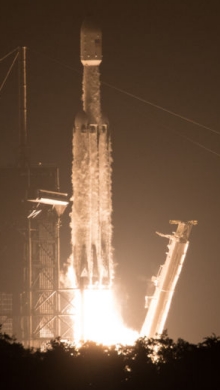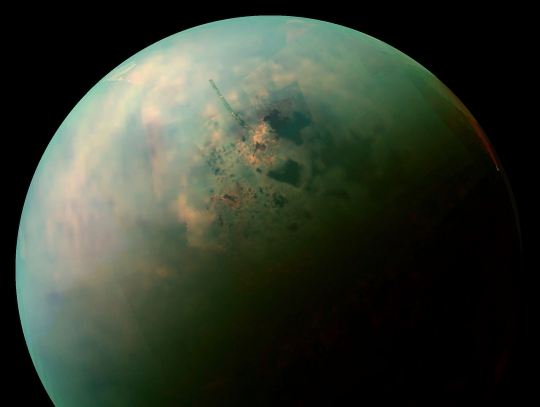
Night launches are spectacular, that’s for sure, especially with a rocket as muscular as the SpaceX Falcon Heavy. Less spectacular, at least at this point in my life, is staying up until 0230, but delays are part of the rocket business, and what counts is a launch successful in everything but the return of the center booster (both side boosters landed upright at Cape Canaveral). Prox-1, the carrier vehicle for The Planetary Society’s LightSail 2, was released at 720 kilometers, with deployment of the sail itself scheduled for July 2.
While we wait for LightSail developments and also follow the fortunes of NASA’s Deep Space Atomic Clock, launched as one of 24 satellites deployed by this bird, the 2019 Astrobiology Science Conference in Seattle draws attention this morning with new information about Saturn’s tantalizing moon Titan. I’m still having to adapt to not having Cassini in Saturn space, but without its presence scientists are proceeding with laboratory studies that re-create conditions like those on the surface of Titan. Among their findings: Compounds and minerals not found on Earth, including a ‘co-crystal’ composed of solid acetylene and butane.
I had to look this one up. A co-crystal (often written without the hyphen) is a molecular crystal with multiple components. An evidently authoritative source (G.P. Stahly, writing in a journal called Crystal Growth & Design in 2007), says that co-crystals “consist of two or more components that form a unique crystalline structure having unique properties.” In the case of the work presented by JPL’s Morgan Cable at the Astrobiology Science Conference, both acetylene and butane appear as gases on Earth, but on Titan, they are solid and combine to form crystals.
The mineral Cable’s team identified in the lab may account for a surface feature found in Cassini imagery in the form of orange shadings around the edges of Titan’s seas and lakes. We know that some of these areas show signs of evaporated material left behind as the liquid receded. These bright features show up in data from the spacecraft’s Visual and Infrared Mapping Spectrometer (VIMS) and Synthetic Aperture Radar (SAR) around lakes in the north polar region. The thinking is that organic molecules generated in the atmosphere and deposited on the surface dissolve in liquid methane and ethane and precipitate when it evaporates.

Image: A false-color, near infrared view of Titan’s northern hemisphere collected by NASA’s Cassini spacecraft shows the moon’s seas and lakes. Orange areas near some of them may be deposits of organic evaporite minerals left behind by receding liquid hydrocarbon. Credit: NASA / JPL-Caltech / Space Science Institute.
To investigate, the scientists used a cryostat filled with liquid nitrogen, gradually warming the chamber until the nitrogen turned to gas, and then adding methane and ethane along with other carbon-containing molecules. Benzene crystals emerged from the mix, creating a co-crystal with ethane molecules. The acetylene and butane co-crystal, likely more common on Titan given the moon’s composition, was then discovered. Other undiscovered hydrocarbon crystals may exist, say the researchers, although finding them will require a mission to Titan’s shorelines.
At surface temperatures in the range of 90 K, the authors believe, the acetylene-butane co-crystal “…may be ubiquitous in these regions of Titan’s surface.” Cable and colleagues are interested in chemical gradients that could potentially be exploited by life, as their presentation notes:
The catalytic hydrogenation of acetylene has been proposed as a possible energy-yielding reaction for metabolism (Schulze-Makuch et al. 2005; McKay et al. 2005; Tokano et al. 2009). It is possible that acetylene-based co-crystals might be a mechanism for storing acetylene, in a manner similar to how carbon dioxide is stored in carbonate deposits on Earth, where it might be more readily accessible to a putative microbial community.
What a complex place we’re dealing with, one whose atmosphere undergoes chemical reactions that produce organic molecules that wind up on the surface, where chemical reactions may occur as the landscape is manipulated by frigid winds and rain. A liquid water ocean beneath the surface may exchange materials with the surface over long timeframes. Being discussed at the conference is the question of whether conditions on Titan could produce the chemical complexity and particularly the energy life would demand. We’re a long way from the answer.
The presentation is Cable et al., “The Acetylene-Butane Co-Crystal: A Potentially Abundant Molecular Mineral on Titan,” with abstract here.



Happy to see that not all researchers follow the dogma equating habitability to liquid water. Best luck to them!
Thanks Paul
Another interesting and excellent update on Titan.
Cheers
The complexity of the molecular machinery we call life has obligate dependence on an aqueous milieu. How much of similar machinery can exist at Titan’s temperatures? The ubiquity of carbonaceous compounds may well be a red herring.
If Titan has a subsurface liquid water “ocean”, then it is possible that life could lurk there. However, as with Europa, the energy flows would be limited to chemical sources and anaerobic.
It is fascinating to speculate that if life exists in these “warm” oceans and a very different life in the cold hydrocarbon surface, that 2 very different biologies could exist on the same world, just permanently separated without technological intervention. It might make for an interesting SciFi story.
Co-crystal instead of liquid???
FIRST-EVER PHOTO OF LIQUID ON EXTRATERRESTRIAL WORLD.
“The Huygens probe has captured an image of what may be the first drop of liquid ever observed on an extraterrestrial surface.
The photo is evidence that liquids may exist on the surface of other planets and moons, not just frozen lakes.
Among the pictures snapped by the Huygens probe after landing on Saturn’s moon Titan in 2005, one appears to show a dewdrop made of methane that briefly formed on the edge of the probe itself (indicated by arrow at bottom of image on right). Scientists think heat from the probe caused humid air to rise and
rise and condense on the cold edge of the craft.
Though Huygens may have helped produce it, the methane drop is still the first liquid directly detected at a surface anywhere beyond Earth.
Like Earth, Titan has clouds, lakes and river channels, and it may be the only other place in the solar system where liquid evaporates from the surface and returns as rain. “Aside from Earth, it’s the most exciting world there is,” said lead author Erich Karkoschka of the University of Arizona in Tucson.
The Cassini space probe, which took data from above the moon after separating from the Huygens lander, detected what scientists believe are lakes of liquid methane on Titan’s surface. Microbes that eat methane thrive on Earth, and scientists think pools of methane could be comfortable homes for similar organisms on Titan.
Because Titan’s current atmosphere is a lot like the early Earth’s, the lakes could be a lab for studying the origins and early evolution of life.
Astronomers have speculated since they found methane in the atmosphere in 1983 about whether the moon’s methane rain falls in violent thunderstorms, light drizzles or some other form. So far, no one has caught it on camera.
The hundreds of images snapped by Huygens, from the time it hit the atmosphere until its power ran out an hour after it landed, revealed only faint, wispy clouds that looked nothing like rain clouds, Karkoschka said.
None of the images showed evidence that it had rained during the previous few years, according to an analysis to be published in the journal Icarus. And some images suggested that Titan’s lower atmosphere was full of small dust particles, which would have been cleared out by rain.
But the scientists noticed light splotches in some of the pictures that hadn’t been there moments before. Some of them had spots that initially looked like raindrops because of their uniform size and smooth edges, but analysis showed they were most likely electronic imprints created by cosmic rays.
However, Karkoschka said, “One of those spots was so big that it really cannot be a cosmic ray.” He concluded that it was a real, short-lived dewdrop, so close to the camera that it must have condensed on a cold metal shield designed to protect the camera lens from direct sunlight.
Robert West, a planetary scientist at the Jet Propulsion Lab in Pasadena, California, thinks the dewdrop is “a cute observation,” but he’s more interested in the lack of rainfall. “There are reports in the literature that concluded there is a drizzle going on near the surface,” he said. “The fact that Huygens didn’t find anything is significant.”
ww.wired.com/2008/12/titanmethane/amp
https://www.wired.com/images_blogs/photos/uncategorized/2008/12/15/wiredtitan2_2.jpg?intcid=inline_amp
Any possible life on Titan would operate at a glacial pace. We might not even be able to detect it is living, as it would appear as a still life.
Mammals and birds are horrifically inefficient with energy compared to cold-blooded creatures. Natural selection on Earth favours the quick. Part of that is that there is plenty of energy available. On a world like Titan, being quick has a higher relative cost than on Earth, and the natural selection pointer would be set at a lower energy setting. That does not mean life is impossible, just slower.
The problem with biology on a cold body like Titan, is that the time scale would be much longer; Reactions are so much faster at higher temperatures that lift ought to be able to evolve faster on a water world like Earth than a cryogenic world like Titan.
Life might be evolving there, but still stuck in early pre-biology, just due to the different time scale.
Just in: Dragonfly is selected as the New Frontiers mission. So, who knows, if it works long enough: maybe it will reach one of these lakes…
https://www.jhuapl.edu/PressRelease/190627b
Guardian has a story on how little coverage the Titan landing got. I really don’t remember it. Unusual because even my late mother who spent her last year’s watching NASA tv. She missed it. She was daughter of an engineer. Never missed Can’t let that happen again. The drone plan for a landing site is really interesting.